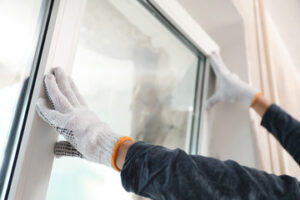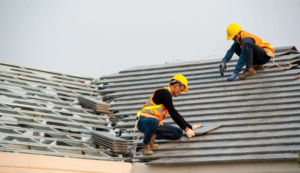Window Replacement allows homeowners to upgrade their home’s style and functionality without having to remove existing trim or molding. However, the level of skills required for a successful project depends on the installation method.

Whether installing a full-frame or insert window, it’s important to accurately measure the frame for a snug fit. For example, to get the height of the window sill, measure from the sill to the head jamb on each side.
Window replacement is one of the best investments you can make for your home. It improves energy efficiency, boosts curb appeal and increases value. However, you must choose the right windows for your home to get all of these benefits.
Window style, frame material and color, and size are all factors that affect your home’s overall appearance. The right windows will blend seamlessly with the architectural style of your house and complement the other exterior elements for a cohesive look that draws attention from passersby.
Old, drafty windows are not only unattractive but also contribute to high energy bills. New windows with advanced insulation technologies, like double or triple panes and low-E coatings, help to keep your home warm in the winter and cool in the summer, significantly cutting down on heating and cooling costs.
Whether you are a homeowner who is looking to update your existing home or prepare it for resale, new windows will increase your home’s curb appeal. Replacing old, outdated, or mismatched windows with new, sleek and stylish models helps to create a welcoming first impression for guests and potential buyers.
Modern windows are designed to maximize natural light and scenic views, brightening interior spaces and enhancing the overall look of your home’s aesthetic. From picture windows that frame a stunning view to elegantly curved bay windows, there are endless options for homeowners who want to elevate the look of their homes’ interiors.
Full frame replacement is a more extensive installation process than partial replacement, but it offers more flexibility when it comes to changing the size and style of your windows. For example, you can replace a difficult-to-reach double hung window over the kitchen sink with an easy-to-open awning window. New windows can also reduce unwanted noise, making your home more serene and comfortable. Depending on your location and local regulations, you may be eligible for rebates or financial incentives related to the energy-efficiency features of your new windows. Check with your local government, utility company, and energy-efficiency programs to learn more.
Repair Damaged Panes
If you have a window pane that has cracked or broken, it will not only be unsightly, but it could also leave your home vulnerable to water and air leaks, leading to mold and mildew problems. Replacing a damaged window pane is an easy DIY project that can be done quickly and will save you money in the long run.
Before installing the new pane, you must remove the old putty. If the putty is too hard to scrape, use a heat gun to gradually soften it. Applying the heat to a section at a time will prevent the glass from cracking, and once it’s warm enough to work with, use the tool’s pointed end to pry it up. Place a piece of aluminum foil over the adjacent panes to dissipate the heat, and work carefully not to break the glass.
Once the old putty is removed, you can measure the opening and order a new piece of glass. A hardware or home improvement store will cut the glass to size, and it is best to order the glass slightly smaller than the opening in the frame, as this allows for a better fit. Once the new glass is cut, you can test it in the frame to ensure a snug fit and to see if any additional silicone caulk needs to be applied around its perimeter.
Another common issue is a rotting window frame. This can be caused by heavy rain, snow melt, or humidity and will weaken the frame over time. If not repaired, the frame can collapse, and if this happens, your windows will no longer open or close.
Besides rot and decay, damaged frames can also cause sticking sashes or hinges and may be a safety concern in the event of an emergency. Replacing the sash and frame will prevent these issues from getting worse, but it is also an opportunity to upgrade to energy efficient windows.
If your frames are rotting or the wood has been compromised by mold or mildew, it is best to replace them rather than repair them. Replacing your old single-pane windows with insulated glass units (IGUs) can save you money in the long run, and they will help to reduce your heating and cooling costs.
Save Money on Energy Bills
If you notice that your home is drafty, or if you are paying high energy bills, it could be a sign that it’s time to invest in new replacement windows. Energy-efficient windows are designed to keep your home cooler in the summer and warmer in the winter, reducing the need for expensive HVAC systems to run constantly. According to Energy Star, replacing old windows with energy-efficient options can save homeowners 12% to 33% annually on their energy bills.
Replacing your windows with modern, insulated frames will also help reduce outside noises and create a more comfortable indoor environment. Many older single-pane windows allow outside noises to penetrate into the home, including traffic and construction sounds. This can be very distracting and cause sleep disturbances, especially for children and pets. Energy-efficient replacement windows can greatly reduce outside noises, creating a quieter indoor space to relax and unwind.
Old windows may develop gaps that let in cold air and heat, making them a breeding ground for harmful molds and allergens. This is why it’s important to replace your window seals whenever they are cracked or damaged, as soon as possible to prevent air leakage and infiltration of unwanted substances. New replacement windows create an incredibly tight seal to ensure no drafts or air infiltration. Additionally, all new windows have at least two panes that are filled with argon or krypton gas to further reduce energy loss. Some have even three panes for maximum efficiency.
In addition to lowering your energy costs, you can also benefit from tax credits and rebates offered by the government and utility companies for upgrading to more efficient windows. These financial incentives can significantly offset the initial investment of your window replacement project.
Whether you are planning to stay in your home for the long term or plan on selling it down the road, window replacement is a worthwhile investment that will add value and curb appeal to your property. Replacing your windows with Energy Star rated models will make your home more attractive to buyers and help you get the most out of your investment.
Add Value to Your Home
When it comes to home improvements that add value to your property, window replacement ranks high. According to Consumer Reports, it can boost your home’s resale value up to 85%! That’s a solid return on investment, especially considering the fact that new windows can also lead to energy savings.
If your windows are old and in disrepair, they can detract from the overall appearance of your home. They can look worn, with broken latches and cracking frames. Older windows also tend to be less energy efficient, allowing cold air in during winter and hot air during summer. This can increase your energy costs significantly over time and can be a turnoff for potential buyers.
Newer windows are more likely to be energy-efficient and meet the needs of today’s homeowners. They offer improved security, such as double- or triple-pane glass that’s harder to break and stronger frame materials that include reinforcements for added strength. They also provide natural light, which can make rooms appear larger and brighter.
Aside from their aesthetics and energy efficiency, new windows can also enhance the curb appeal of your home, making it more inviting to prospective buyers. When choosing a style for your new windows, consider the architectural style of your home and choose a design that fits in well. Also, be sure to choose windows that complement the existing color and material of your home’s siding and trim for a cohesive look.
Whether or not your home improvement projects will increase its value when it’s time to sell depends on several factors, including the quality of the renovation and your local real estate market. However, there is no doubt that if you replace your old, inefficient windows with new, energy-efficient models, you’ll improve the overall look and feel of your home and increase its resale value. Contact a professional window company to find out what type of windows best suit your home’s architecture and your local weather conditions. They can help you determine if a full-frame installation or pocket replacement is the right option for your home.

